airbag Acura MDX 2011 Owner's Manual
[x] Cancel search | Manufacturer: ACURA, Model Year: 2011, Model line: MDX, Model: Acura MDX 2011Pages: 609, PDF Size: 12.7 MB
Page 3 of 609

California Proposition 65 Warning
WARNING:This product contains or emits chemicals known to the State of California to cause cancer and birth
defects or other reproductive harm.Event Data Recorders
This vehicle is equipped with one or more devices commonly referred to as event data recorders. These
devices record front seat belt use, front passenger seat occupancy, airbag deployment data, and the failure of
any airbag system component. This data belongs to the vehicle owner and may not be accessed by anyone else
except as legally required or with the permission of the vehicle owner.Service Diagnostic Recorders
This vehicle is equipped with service-related devices that record information about powertrain performance. The data
can be used to verify emissions law requirements and/or help technicians diagnose and solve service problems. It
may also be combined with data from other sources for research purposes, but it remains confidential.California Perchlorate Contamination Prevention Act
The airbags, seat belt tensioners, and CR type batteries in this vehicle may contain perchlorate materials - special
handling may apply. See
www.dtsc.ca.gov/hazardouswaste/perchlorate/
Introductionii10/06/29 11:59:04 11 ACURA MDX MMC North America Owner's M 50 31STX640 enu
Page 8 of 609

ꭧ: If equippedDRIVER'S FRONT
AIRBAG (P. 10, 29)
DRIVING POSITION
MEMORY SYSTEM
(P. 166)
POWER DOOR LOCK
MASTER SWITCH
(P. 139)
PARKING BRAKE
RELEASE HANDLE
(P. 163)
POWER WINDOW
SWITCHES
(P. 158)
FUEL FILL DOOR
RELEASE BUTTON
(P. 419)
POWER TAILGATE
BUTTON (P. 141)
HOOD RELEASE
HANDLE (P. 421) PARKING BRAKE
PEDAL (P. 163)AUXILIARY INPUT
JACKS
ꭧ(P. 336)HEADPHONE
CONNECTORS
ꭧ(P. 337)
INSTRUMENT PANEL
INDICATORS (P. 65)
HOMELINK BUTTONS
(P. 360)
MOONROOF SWITCH
(P. 161) MIRROR CONTROL
AUTO BUTTON
(P. 163)
PASSENGER'S
FRONT AIRBAG
(P. 10, 29)
CLIMATE CONTROL
SYSTEM (P. 180)
AUDIO SYSTEM
(P. 190) AUTOMATIC
TRANSMISSION
(P. 437)
REAR CLIMATE
CONTROL SYSTEM
(P. 185)
GAUGES (P. 76)
AC POWER OUTLET
(P. 176)
USB ADAPTER
CABLE
ꭧ(P. 277)
AUXILIARY INPUT
JACKS (P. 304)
CONTINUED
Your Vehicle at a Glance
3
Your Vehicle at a Glance
10/06/29 11:59:04 11 ACURA MDX MMC North America Owner's M 50 31STX640 enu
Page 9 of 609
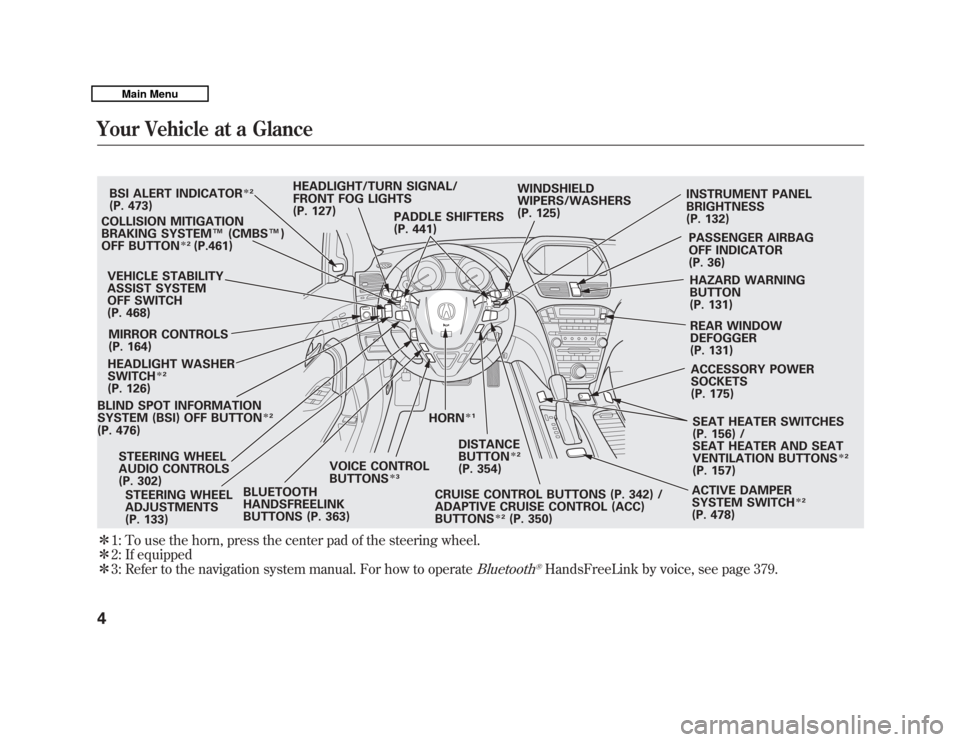
ꭧ1: To use the horn, press the center pad of the steering wheel.
ꭧ 2: If equipped
ꭧ 3: Refer to the navigation system manual. For how to operate
Bluetooth
®HandsFreeLink by voice, see page 379.
BLIND SPOT INFORMATION
SYSTEM (BSI) OFF BUTTON
ꭧ2
(P. 476)VEHICLE STABILITY
ASSIST SYSTEM
OFF SWITCH
(P. 468)
MIRROR CONTROLS
(P. 164)BSI ALERT INDICATOR
ꭧ
2
(P. 473)
COLLISION MITIGATION
BRAKING SYSTEM ™(CMBS ™)
OFF BUTTON
ꭧ 2
(P.461)
HEADLIGHT WASHER
SWITCH
ꭧ 2
(P. 126)
HORN
ꭧ1
STEERING WHEEL
ADJUSTMENTS
(P. 133) HEADLIGHT/TURN SIGNAL/
FRONT FOG LIGHTS
(P. 127)
STEERING WHEEL
AUDIO CONTROLS
(P. 302) WINDSHIELD
WIPERS/WASHERS
(P. 125)
INSTRUMENT PANEL
BRIGHTNESS
(P. 132)
PASSENGER AIRBAG
OFF INDICATOR
(P. 36)HAZARD WARNING
BUTTON
(P. 131)
REAR WINDOW
DEFOGGER
(P. 131) ACCESSORY POWER
SOCKETS
(P. 175)
SEAT HEATER SWITCHES
(P. 156) /
SEAT HEATER AND SEAT
VENTILATION BUTTONS
ꭧ 2
(P. 157)
ACTIVE DAMPER
SYSTEM SWITCH
ꭧ 2
(P. 478)
CRUISE CONTROL BUTTONS (P. 342) /
ADAPTIVE CRUISE CONTROL (ACC)
BUTTONS
ꭧ
2
(P. 350)
PADDLE SHIFTERS
(P. 441)
DISTANCE
BUTTONꭧ2
(P. 354)
BLUETOOTH
HANDSFREELINK
BUTTONS (P. 363) VOICE CONTROL
BUTTONS
ꭧ
3
Your Vehicle at a Glance410/06/29 11:59:04 11 ACURA MDX MMC North America Owner's M 50 31STX640 enu
Page 10 of 609
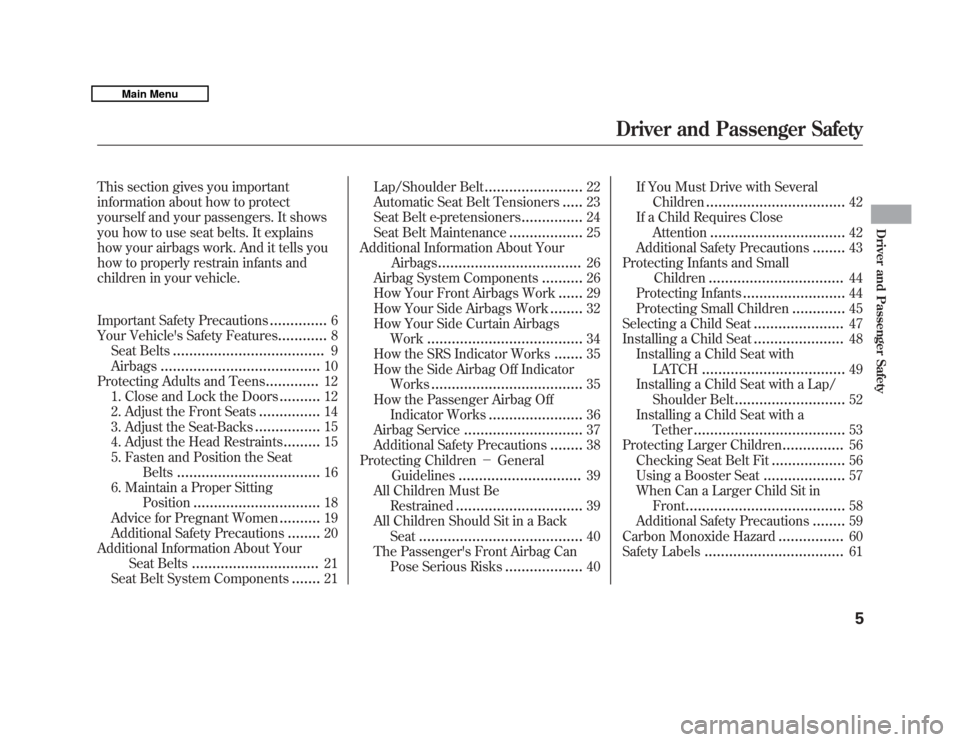
This section gives you important
information about how to protect
yourself and your passengers. It shows
you how to use seat belts. It explains
how your airbags work. And it tells you
how to properly restrain infants and
children in your vehicle.
Important Safety Precautions
..............
6
Your Vehicle's Safety Features
............
8
Seat Belts
.....................................
9
Airbags
.......................................
10
Protecting Adults and Teens
.............
12
1. Close and Lock the Doors
..........
12
2. Adjust the Front Seats
...............
14
3. Adjust the Seat-Backs
................
15
4. Adjust the Head Restraints
.........
15
5. Fasten and Position the Seat Belts
...................................
16
6. Maintain a Proper Sitting Position
...............................
18
Advice for Pregnant Women
..........
19
Additional Safety Precautions
........
20
Additional Information About Your Seat Belts
...............................
21
Seat Belt System Components
.......
21 Lap/Shoulder Belt
........................
22
Automatic Seat Belt Tensioners
.....
23
Seat Belt e-pretensioners
...............
24
Seat Belt Maintenance
..................
25
Additional Information About Your
Airbags
...................................
26
Airbag System Components
..........
26
How Your Front Airbags Work
......
29
How Your Side Airbags Work
........
32
How Your Side Curtain Airbags Work
......................................
34
How the SRS Indicator Works
.......
35
How the Side Airbag Off Indicator Works
.....................................
35
How the Passenger Airbag Off Indicator Works
.......................
36
Airbag Service
.............................
37
Additional Safety Precautions
........
38
Protecting Children -General
Guidelines
..............................
39
All Children Must Be Restrained
...............................
39
All Children Should Sit in a Back Seat
........................................
40
The Passenger's Front Airbag Can Pose Serious Risks
...................
40 If You Must Drive with Several
Children
..................................
42
If a Child Requires Close Attention
.................................
42
Additional Safety Precautions
........
43
Protecting Infants and Small Children
.................................
44
Protecting Infants
.........................
44
Protecting Small Children
.............
45
Selecting a Child Seat
......................
47
Installing a Child Seat
......................
48
Installing a Child Seat with LATCH
...................................
49
Installing a Child Seat with a Lap/
Shoulder Belt
...........................
52
Installing a Child Seat with a Tether
.....................................
53
Protecting Larger Children
...............
56
Checking Seat Belt Fit
..................
56
Using a Booster Seat
....................
57
When Can a Larger Child Sit in Front
.......................................
58
Additional Safety Precautions
........
59
Carbon Monoxide Hazard
................
60
Safety Labels
..................................
61
Driver and Passenger Safety
5
Driver and Passenger Safety
10/06/29 11:59:04 11 ACURA MDX MMC North America Owner's M 50 31STX640 enu
Page 11 of 609
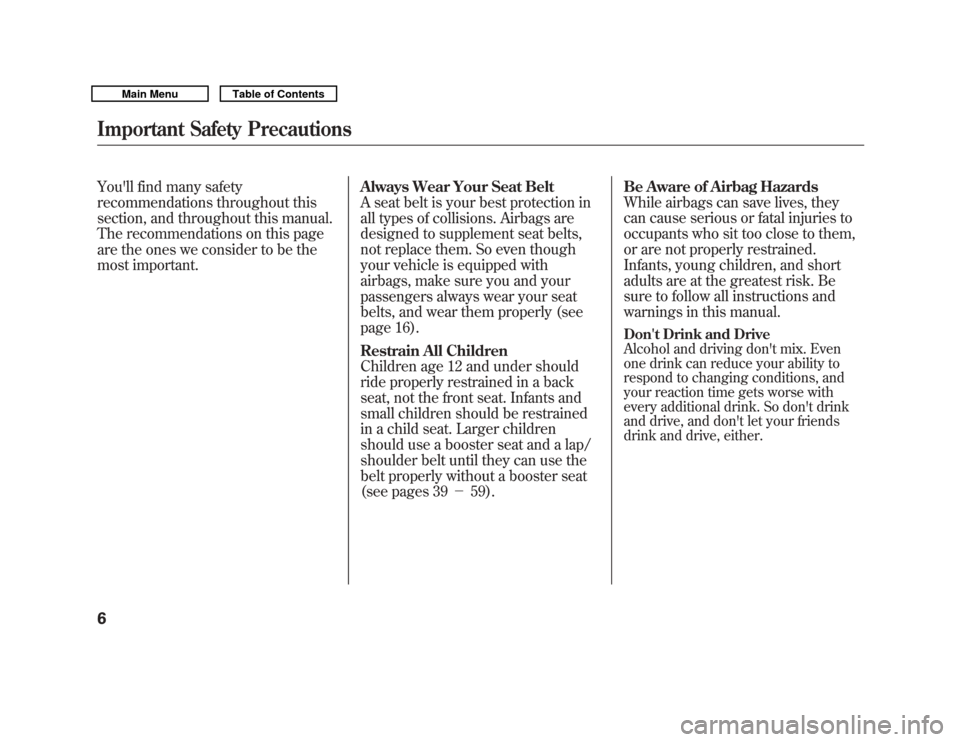
You'll find many safety
recommendations throughout this
section, and throughout this manual.
The recommendations on this page
are the ones we consider to be the
most important.Always Wear Your Seat Belt
A seat belt is your best protection in
all types of collisions. Airbags are
designed to supplement seat belts,
not replace them. So even though
your vehicle is equipped with
airbags, make sure you and your
passengers always wear your seat
belts, and wear them properly (see
page 16).
Restrain All Children
Children age 12 and under should
ride properly restrained in a back
seat, not the front seat. Infants and
small children should be restrained
in a child seat. Larger children
should use a booster seat and a lap/
shoulder belt until they can use the
belt properly without a booster seat
(see pages 39
-59). Be Aware of Airbag Hazards
While airbags can save lives, they
can cause serious or fatal injuries to
occupants who sit too close to them,
or are not properly restrained.
Infants, young children, and short
adults are at the greatest risk. Be
sure to follow all instructions and
warnings in this manual.
Don't Drink and DriveAlcohol and driving don't mix. Even
one drink can reduce your ability to
respond to changing conditions, and
your reaction time gets worse with
every additional drink. So don't drink
and drive, and don't let your friends
drink and drive, either.
Important Safety Precautions610/06/29 11:59:04 11 ACURA MDX MMC North America Owner's M 50 31STX640 enu
Page 13 of 609
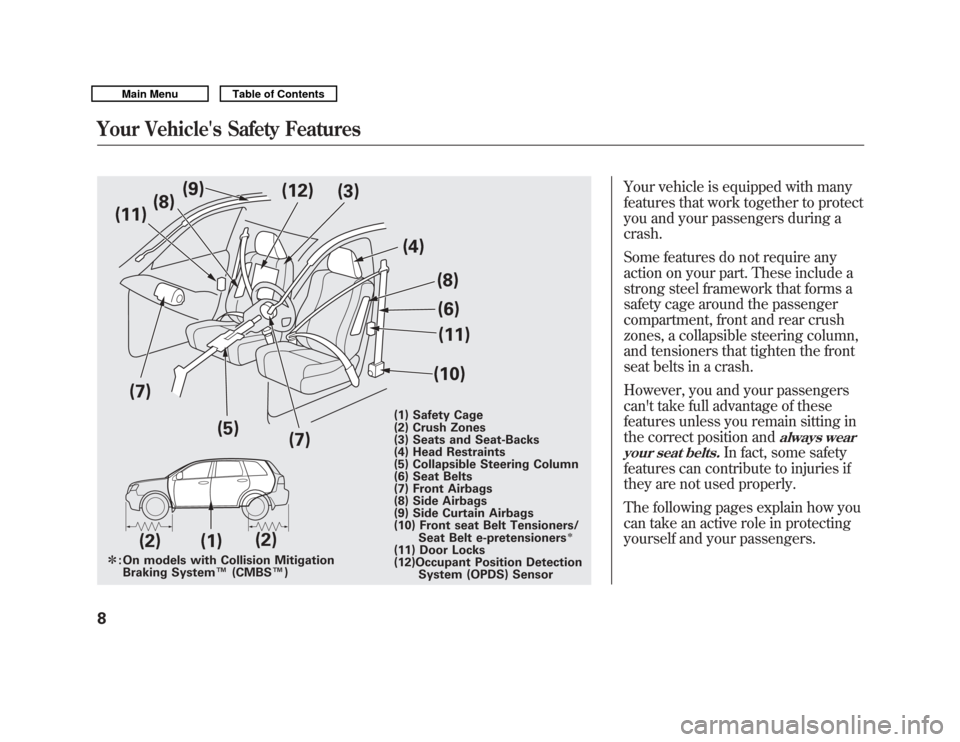
Your vehicle is equipped with many
features that work together to protect
you and your passengers during a
crash.
Some features do not require any
action on your part. These include a
strong steel framework that forms a
safety cage around the passenger
compartment, front and rear crush
zones, a collapsible steering column,
and tensioners that tighten the front
seat belts in a crash.
However, you and your passengers
can't take full advantage of these
features unless you remain sitting in
the correct position and
always wear
your seat belts.
In fact, some safety
features can contribute to injuries if
they are not used properly.
The following pages explain how you
can take an active role in protecting
yourself and your passengers.
(1) Safety Cage
(2) Crush Zones
(3) Seats and Seat-Backs
(4) Head Restraints
(5) Collapsible Steering Column
(6) Seat Belts
(7) Front Airbags
(8) Side Airbags
(9) Side Curtain Airbags
(10) Front seat Belt Tensioners/ Seat Belt e-pretensioners
ꭧ
(11) Door Locks
(12)Occupant Position DetectionSystem (OPDS) Sensor
(1) (3)
(7)
(5)
(2) (11)
(6)
(10) (8)
(2) (9)
(4)
On models with Collision Mitigation
Braking System™(CMBS ™)
ꭧ
:(11) (8)
(12)
(7)
Your Vehicle's Safety Features810/06/29 11:59:04 11 ACURA MDX MMC North America Owner's M 50 31STX640 enu
Page 14 of 609
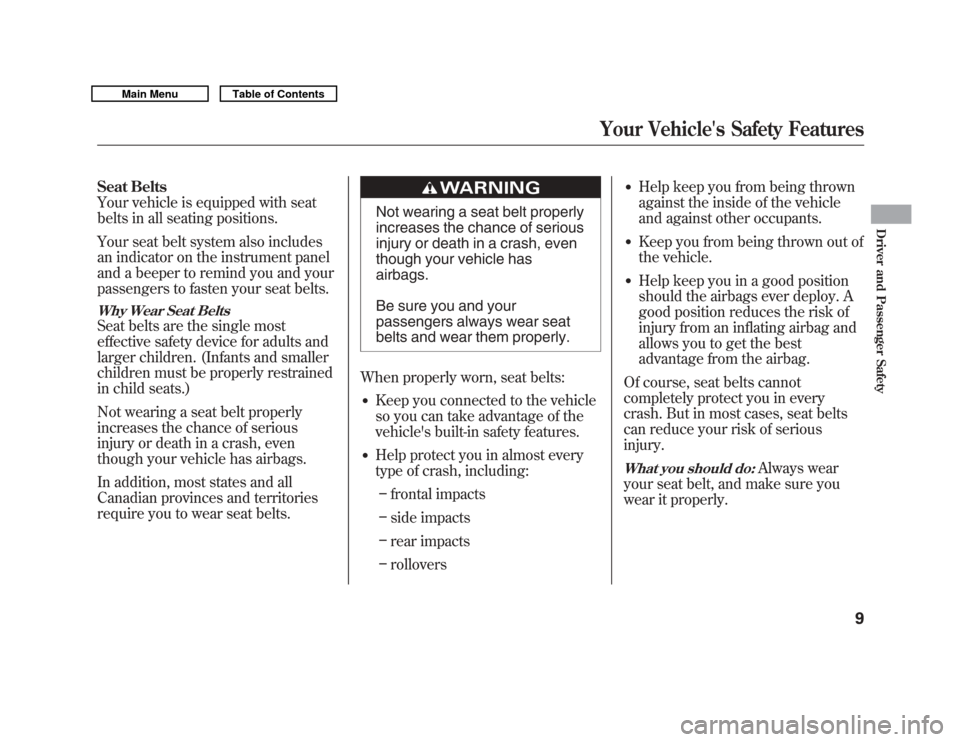
Seat Belts
Your vehicle is equipped with seat
belts in all seating positions.
Your seat belt system also includes
an indicator on the instrument panel
and a beeper to remind you and your
passengers to fasten your seat belts.Why Wear Seat BeltsSeat belts are the single most
effective safety device for adults and
larger children. (Infants and smaller
children must be properly restrained
in child seats.)
Not wearing a seat belt properly
increases the chance of serious
injury or death in a crash, even
though your vehicle has airbags.
In addition, most states and all
Canadian provinces and territories
require you to wear seat belts.
Not wearing a seat belt properly
increases the chance of serious
injury or death in a crash, even
though your vehicle has
airbags.
Be sure you and your
passengers always wear seat
belts and wear them properly.
When properly worn, seat belts:
●
Keep you connected to the vehicle
so you can take advantage of the
vehicle's built-in safety features.
●
Help protect you in almost every
type of crash, including: – frontal impacts
– side impacts
– rear impacts
– rollovers
●
Help keep you from being thrown
against the inside of the vehicle
and against other occupants.
●
Keep you from being thrown out of
the vehicle.
●
Help keep you in a good position
should the airbags ever deploy. A
good position reduces the risk of
injury from an inflating airbag and
allows you to get the best
advantage from the airbag.
Of course, seat belts cannot
completely protect you in every
crash. But in most cases, seat belts
can reduce your risk of serious
injury.
What you should do:
Always wear
your seat belt, and make sure you
wear it properly.
Your Vehicle's Safety Features
9
Driver and Passenger Safety
10/06/29 11:59:04 11 ACURA MDX MMC North America Owner's M 50 31STX640 enu
Page 15 of 609
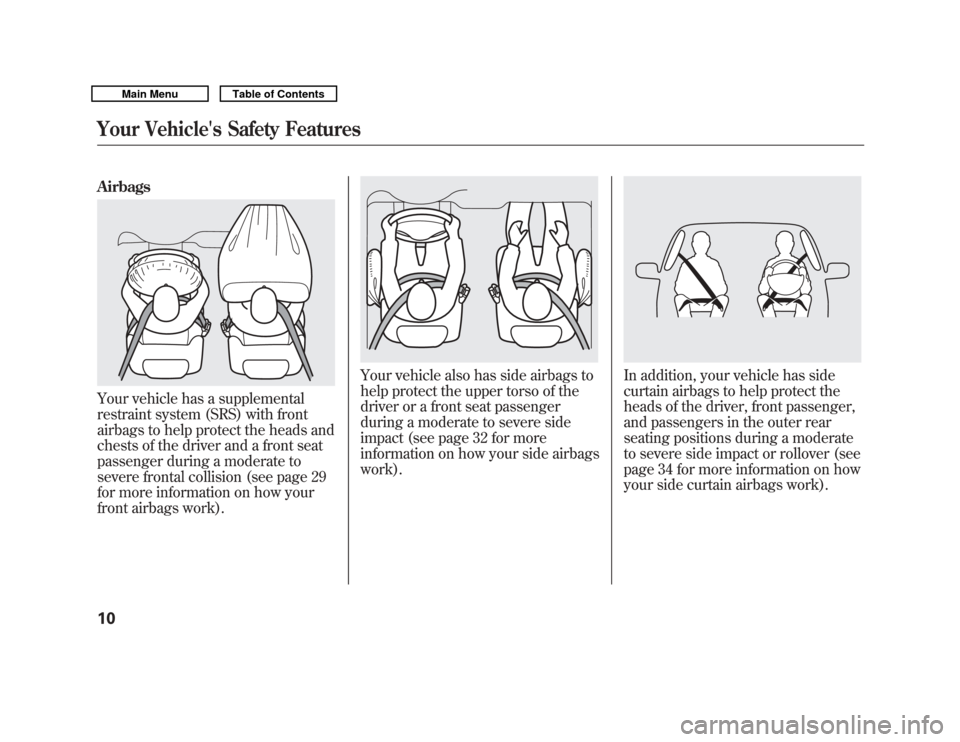
AirbagsYour vehicle has a supplemental
restraint system (SRS) with front
airbags to help protect the heads and
chests of the driver and a front seat
passenger during a moderate to
severe frontal collision (see page 29
for more information on how your
front airbags work).
Your vehicle also has side airbags to
help protect the upper torso of the
driver or a front seat passenger
during a moderate to severe side
impact (see page 32 for more
information on how your side airbags
work).
In addition, your vehicle has side
curtain airbags to help protect the
heads of the driver, front passenger,
and passengers in the outer rear
seating positions during a moderate
to severe side impact or rollover (see
page 34 for more information on how
your side curtain airbags work).
Your Vehicle's Safety Features1010/06/29 11:59:04 11 ACURA MDX MMC North America Owner's M 50 31STX640 enu
Page 16 of 609
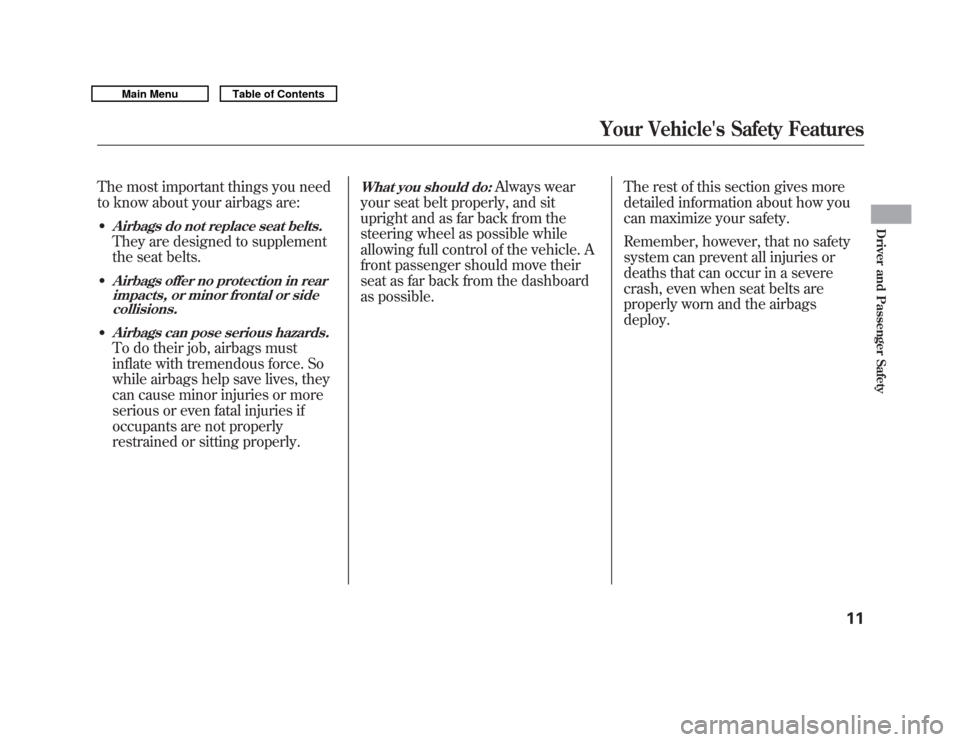
The most important things you need
to know about your airbags are:●
Airbags do not replace seat belts.They are designed to supplement
the seat belts.
●
Airbags offer no protection in rearimpacts, or minor frontal or sidecollisions.
●
Airbags can pose serious hazards.To do their job, airbags must
inflate with tremendous force. So
while airbags help save lives, they
can cause minor injuries or more
serious or even fatal injuries if
occupants are not properly
restrained or sitting properly.
What you should do:
Always wear
your seat belt properly, and sit
upright and as far back from the
steering wheel as possible while
allowing full control of the vehicle. A
front passenger should move their
seat as far back from the dashboard
as possible. The rest of this section gives more
detailed information about how you
can maximize your safety.
Remember, however, that no safety
system can prevent all injuries or
deaths that can occur in a severe
crash, even when seat belts are
properly worn and the airbags
deploy.
Your Vehicle's Safety Features
11
Driver and Passenger Safety
10/06/29 11:59:04 11 ACURA MDX MMC North America Owner's M 50 31STX640 enu
Page 19 of 609

2. Adjust the Front SeatsAdjust the driver's seat as far to the
rear as possible while allowing you to
maintain full control of the vehicle.
Have a front passenger adjust their
seat as far to the rear as possible.If you sit too close to the steering
wheel or dashboard, you can be
seriously injured by an inflating front
airbag, or by striking the steering
wheel or dashboard.
The National Highway Traffic Safety
Administration and Transport
Canada recommend that drivers
allow at least 10 inches (25 cm)
between the center of the steering
wheel and the chest. In addition to
adjusting the seat, you can adjust the
steering wheel up and down, and in
and out (see page 133).
If you cannot get far enough away
from the steering wheel and still
reach the controls, we recommend
that you investigate whether some
type of adaptive equipment may help.
Sitting too close to a front
airbag can result in serious
injury or death if the front
airbags inflate.
Always sit as far back from the
front airbags as possible.
See page 148 for how to adjust the
front seats.
Protecting Adults and Teens1410/06/29 11:59:04 11 ACURA MDX MMC North America Owner's M 50 31STX640 enu